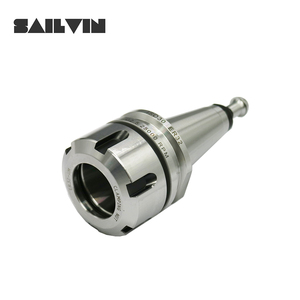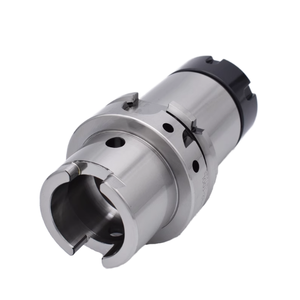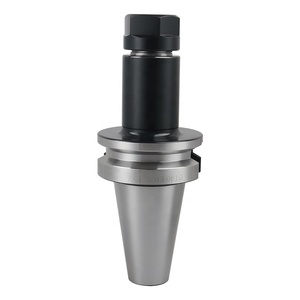(1053 products available)











































































































































































































































Balanced tool holders are specialized tool holders that minimize vibrations during machining operations, improving precision and cutting performance.
Balanced CAT/BT tool holders
They are standard taper-shaped tool holders with a balance feature integrated into their design. The balance feature usually involves adding or repositioning weights within the tool holder to counteract any imbalances caused by the cutting tool. Balanced CAT/BT tool holders enhance the stability of machines, especially at high rotation speeds.
Balanced HSK tool holders
Like the balanced CAT/BT tool holders, they incorporate a built-in balancing mechanism to ensure smooth running. They are suited for high-speed machining applications that demand accuracy and quality. Balanced HSK tool holders improve machine performance by reducing wear and tear of spindle bearings that usually result from vibrations. They also extend the lifespan of cutting tools.
Pre-balanced tool holders
They are tool holders that are dynamically balanced during manufacturing. They are manufactured using precision machining techniques and are ideal for high-speed machining operations. Pre-balanced tool holders offer users the benefits of reduced vibrations, enhanced stability, and improved machining accuracy.
Specifications of balanced tool holders
Balanced tool holders have various specification models. So the specific required tool holder specifications depend on the cutting tool and machining center. These include an interface, bar diameter, gripping mechanism, imbalance degree, runout, and length.
Interface
Balanced tool holder interfaces connect with CNC machines. These interfaces include CAT, BT, HSK, and others, ensuring compatibility with machining systems.
Bar Diameter
The shank diameter of a balanced tool holder is compatible with cutting tools, including metric sizes like 16mm, 20mm, and imperial sizes like 1 inch, 1.5 inches, etc.
Gripping Mechanism
Balanced tool holders feature a gripping method that includes set screws, locking nuts, and collets, providing secure tool retention during operation.
Imbalance Degree
The imbalance degree rating of a balanced tool holder indicates the level of balance precision. It may be one, two, or three, making it suitable for various speed applications.
Runout
The tool holder's runout may affect the cutting accuracy and operation. Balanced tool holders usually have the runout that is 0.004mm or 0.005mm.
Length
Balanced tool holder lengths offer options to reach and work in tight spaces.
Maintenance of balanced tool holders
It's critical to maintain the balance tool holders for their performance and tool life. Here are some tips for usage and maintenance:
Industrial machining and manufacturing
Balanced tool holders are the primary equipment used in CNC machine tools such as lathes, milling machines, and machining centers. They are responsible for fixing and holding mechanical parts, work pieces, and cutting tools. Their role is to ensure that work pieces in machining and processing are stable, accurate, easy to operate, and control. Balanced tool holders are vital accessories and have critical importance in industrial machining and manufacturing.
Precision machining
Enterprises that engage in CNC machining as their core business need to pursue high precision and reliability in their machining processes. This is to ensure that the cutting tools used are balanced and stable when rotating at high speeds. Tool holders with dynamic balancing function enable these enterprises to achieve precise machining with a high level of consistency.
Automotive industry
The automotive sector places high demands on the quality and productivity of its products. CNC machining is a crucial step in the manufacturing of various parts and components of automobiles. Balanced tool holders provide stable support and control for cutting tools to ensure precision machining, thereby enhancing the quality and efficiency of automotive production.
Aerospace and aviation industry
The holder for the cutting tool balance is significant, particularly in precision machining operations for parts. These parts often require superior quality and precision standards. Balanced tool holders facilitate the achievement of exceptional accuracy and reliability, thereby ensuring the quality and safety of aviation products.
Medical equipment industry
In the medical equipment manufacturing industry, tool holders for balanced cutting are significant. They are chiefly used to produce parts and components of medical instruments and equipment. The balanced tool holders ensure their stable support and precise control of the cutting tools. This ensures that the precision and quality of medical equipment satisfy relevant standards.
The following factors can help buyers to choose the best balanced tool holders for their businesses.
Machine tools
The type and brand of machine tools using the balanced tool holders is the first consideration. Do the tool holders match the existing CNC machine tools? Is the tool holder compatible with the machine’s spindle? Will it fit into the prescribed tool changers? Also, consider the quantity of tool holders needed to service the existing machine.
Tools
Balanced tool holders must work with the tools used in the machines. The size of the tools, their taper or thread, and the necessary transmission features must align perfectly. For example, the cutting tools require high-torque gearboxes for efficient cutting operations.
Material and finish
Select tool holders made of materials, such as steel alloys, that offer durability and vibration resistance. Also, choose holders with anti-fog surfaces that enable easy tool changes and prevent tool holder fogging.
Precision and balance
Typically, the performance of a CNC machine depends on the precision and balance of the tool holders. Invest in holders with high-precision guiding and clamping systems. Choose tool holders with a good balance to minimize vibration during high-speed operations.
Flexible and fixed holders
Buy flexible tool holders for machining centers with diverse operations. Consider fixed tool holders for dedicated CNC lathes that only use one specific tool.
Collet chucks
Based on the business needs, consider buying collet chucks or any other specific type of tool holder. Collet chucks are flexible and can hold tools with different shank sizes. Other types of tool holders may provide a higher degree of accuracy or rigidity.
Q: Why are tool holders balanced?
A: To increase stability and diminish vibration when a spindle rotates at higher speeds, which is commonly the case in most machining operations.
Q: What is the relationship between balanced tool holders and end mills?
A: Balanced tool holders are often matched with end mills, which are milling tools used to cut material at different angles and depths.
Q: When should one consider using premium, costly, yet balanced tool holders?
A: This is provided they are using high-performance, expensive end mills that will require the perfect balancing of their tool holder to achieve optimal performance.
Q: What might happen if a tool holder is not balanced?
A: This may cause excessive vibration, leading to premature wear, breakage of the tool, spindle damage or chatter, which is a repetitive vibration that can damage the workpiece.